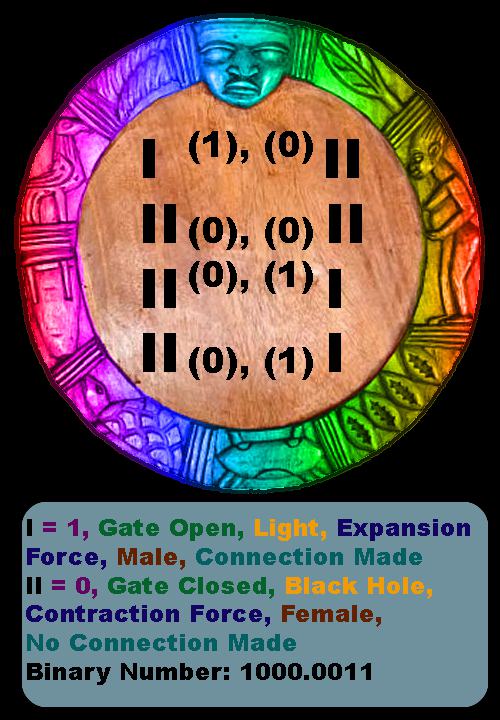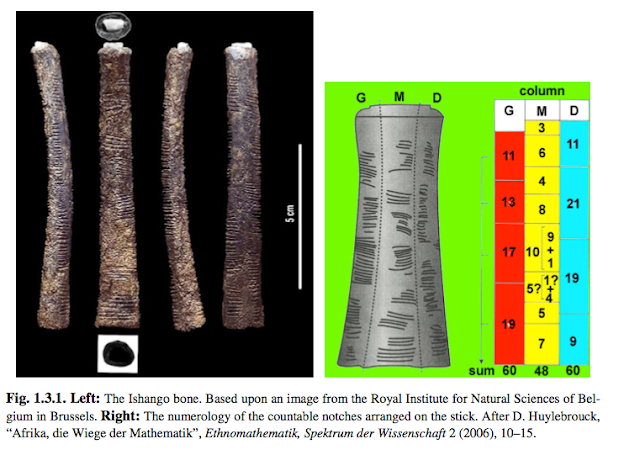Mathematics, Geomancy, Arabic, Ilm Al Raml, Musa al-Khwarizmi, Sylvester James Gates, Thomas Fuller, Final Part
Arabic Geomancy
Ilm Al Raml (the science of the sands)
Ilm al-ghayb (the occult sciences)
Ilm al-Ḥurūf (the science of letters)
It is essential to situate mathematical concepts within atypical cultural and historical contexts that essentialize mathematical thought as embodied expressions of human endeavours. There is an ongoing investigation into the mathematical structures underlying an ancient historical and cultural divination practice known as ilm al-raml (Arabic translation of sand science). Principled by sociohistorical and sociocultural lenses, the study employs an ethnomathematical methodology.
 |
| Ilm Al Raml (the science of the sands) |
Geomancy is a method of divination that interprets markings on the ground or the patterns formed by tossed handfuls of soil, rocks, or sand. The most prevalent form of divinatory geomancy involves interpretation. Interpretation commences with a series of 16 figures formed by a randomized process including recursion, followed by analyzing them, often augmented with astrological interpretations. King Richard II thought geomancy was a greater discipline that included philosophy, science, and alchemic elements.
Richard II, also known as Richard of Bordeaux, was King of England from 1377 until 1399. He was the son of Edward the Black Prince, Prince of Wales, and Joan, Countess of Kent. Wikipedia
Born: 6 January 1367, Bordeaux, France
 |
| Ilm Al Raml (The Science of the Sands) Binary codes and Elements |
Died: 14 February 1400, Pontefract Castle, Pontefract
Siblings: Edward of Angoulême, John Holland, 1st Duke of Exeter, MORE
Spouse: Isabella of Valois (m. 1396–1400), Anne of Bohemia (m. 1382–1394)
Parents: Edward the Black Prince, Joan of Kent
Deposed dates: 1377, 29 September 1399
Many people from different social classes practised geomancy in the Middle Ages. Geomancy was a popular form of divination in Europe, particularly during the Middle Ages, except in Africa and Asia. Renaissance, although in Renaissance magic, geomancy was classified as one of the seven "forbidden arts", along with necromancy, hydromancy, aeromancy, pyromancy, chiromancy (palmistry), and scapulimancy.
 |
| Ilm Al Raml (the science of the sands) Elements |
The reference in Hermetic texts to the mythical Ṭumṭum al-Hindi potentially points to an Indian origin, although Stephen Skinner thinks this unlikely. Having an Arabic origin is most likely because the expansive trade routes of Arabian merchants[when?] would facilitate the exchange of culture and knowledge.
 |
| One of the Symbol of the Hermetic Order of the Golden Dawn |
European scholars and universities started translating Arabic texts and Treatises in the early Middle Ages, including those on geomancy. Isidore of Seville (560 – 636 AD) lists geomancy with other methods of divination – including pyromancy, hydromancy, aeromancy, and necromancy – without describing its application or methods. The poem Experimentarius, attributed to Bernardus Silvestris, who wrote in the middle of the 12th century, was a verse translation of a work on astrological geomancy.
One of the first discourses on geomancy translated into Latin was the Ars Geomantiae of Hugh of Santalla (fl. early 12th century). By this point, geomancy must have been an established divination system in Arabic-speaking areas of Africa and the Middle East. However, archaeological, oral and symbolic evidence counter the Arab originator assertion.
 |
| Sikidy Board Hierarchy |
Other translators, such as Gerard of Cremona, also produced new translations of geomancy that incorporated astrological elements and techniques ignored by many.
More European scholars studied and applied geomancy, writing substantial Treatises. Henry Cornelius Agrippa (1486–1535 AD), Christopher Cattan (La Géomancie du Seigneur Christofe de Cattan (1558 AD), and John Heydon (1629 – 1667 AD) produced oft-cited and well-studied Treatises on geomancy, along with other philosophers, occultists, and theologians until the 17th century, when interest in occultism and divination began to dwindle due to the rise of the Scientific Revolution and the Age of Reason.
Geomancy underwent a revival in the 19th century when renewed interest in the occult arose due to the works of Robert Thomas Cross (1850–1923 AD) and Edward Bulwer-Lytton (1803–1873 AD). Franz Hartmann published his text, The Principles of Astrological Geomancy (English translation: 1889) spurred new interest in the divination system.
 |
Generating Geomantic Charts
Geomancy requires the geomancer to create sixteen lines of points or marks without counting, creating sixteen random numbers. Without taking note of the number of points made, the geomancer provides the seemingly random mechanism needed for most forms of divination. Once produced, the geomancer marks off two by two until either one or two points remain in the line. Mathematically, this is the same as drawing two dots if the number is even or one if the number is odd.
Taking these leftover points in groups of four, they form the first four geomantic figures and form the basis for the regeneration of the remaining figures. Once finished, the "inspired" portion of the geomantic reading expires; what remains is algorithmic calculation.
Traditionally, geomancy requires a surface of sand and the hands or a stick, but also equally well with a wax tablet and stylus or a pen and paper. In divination, ritualistic objects may or may not apply. When drawing marks or figures, geomancers proceed from right to left as a tradition from geomancy's origins, and it is not mandatory. Modern methods of geomancy include, in addition to the traditional ways:
Random number generators or thrown objects; others include counting the eyes on potatoes. Some practitioners use specific cards, each representing a single geomantic figure; in this case, only four cards are drawn after shuffling. Specified machines are needed to generate completed geomantic charts.
The figures are recorded into a specialized table, known as the shield chart, which illustrates the recursive processes reminiscent of the Cantor set that forms the figures. The first four figures are the matres or Mothers and form the basis for the rest of the figures in the chart; they occupy the first four houses in the upper right-hand corner such that the first Mother is to the far right, the second Mother is to her left, and so on (continuing the right-to-left tradition).
The following four figures, the filiae, or Daughters, are formed by rearranging the lines used in the Mothers: the first Daughter is formed by taking the first line from the first, second, third, and fourth Mothers in order and rearranging them to be the first Daughter's first, second, third, and fourth lines, respectively. The process is done similarly for the second Daughter using the second line from the Mother, and so on. The Daughters are placed in the next four houses in order on the same row as the Mothers.
After the formation of eight matres and filiae, the generation of four nepotes (or Nieces) is by adding those pairs of figures that rest above the houses of the respective Niece. Including the first and second Mothers added to form the first Niece, the third and fourth Mothers added to become the second Niece, and so on.
Here, addition involves summing the points in the respective lines of the parents. If the sum is an even number, the resulting figure's line will have two points; if the sum is odd, it is one point. Conceptually, this is the same procedure in mathematical logic as the exclusive or, where a line with two points is used instead of "false" and with one point instead of "true".
The calculation of the binary numbers of the four nepotes, the two testes (or Witnesses) is the same as the nepotes: the first and second Nieces form the Right Witness, and the third and fourth Nieces form the Left Witness. Creating the index or judge technique is the same as the Witnesses. A sixteenth figure, the Reconciler or superiudex, is also generated by adding the Judge and the First Mother. Nowadays, it is seen as extraneous and a "backup figure" in recent times.
 |
| Muhammad ibn Musa al-Khwarizmi |
D’Ambrosio (1985, 1999 ) and Knijnik’s (2000)
Muhammad ibn Musa al-Khwarizmi
Muḥammad ibn Mūsā al-Khwārizmī, or al-Khwarizmi, was a Persian polymath from Khwarazm who produced vastly influential works in mathematics, astronomy, and geography.
He was appointed around 820 AD as the astronomer and head of the library of the House of Wisdom in Baghdad.
Born: Khwarazm
Died: Baghdad, Iraq
Full name: Muḥammad ibn Mūsā al-Khwārizmī
Era: Islamic Golden Age (Abbasid era)
Influenced: Abu Kamil
Main interests: Mathematics, astronomy, geography
Fractals
Fractals are the repetition of similar patterns at ever-diminishing scales. Fractal geometry has emerged as one of the most exciting frontiers on the border between mathematics and information technology. It is in many of the swirling patterns produced by computer graphics.
 |
| Fractals |
Sylvester James Gates
When physicist James Gates discovered recurring codes that dictate the behaviour of every sub-atomic element in the universe, he named it Adinkra.
Sylvester James Gates Jr. (born on 15/12/1950), known as S. James Gates Jr. or Jim Gates, is an American theoretical physicist who works on supersymmetry, supergravity, and superstring theory.
 |
| Sylvester James Gates |
Jim Gates holds the Clark Leadership Chair in Science with the physics department at the University of Maryland College of Computer, Mathematical, and Natural Sciences.
Gates is an affiliate with the University of Maryland School of Public Policy.
He served under former President Barack Obama.
He was a member of the Council of Advisors on Science and Technology.
Thomas Fuller
Thomas Fuller (1710 – December 1790), also known as Negro Demus and the Virginia Calculator, was an enslaved African renowned for his mathematical abilities. Born in Africa, likely between present-day Liberia and Benin, Fuller was enslaved and shipped to America in 1724 AD at age 14. He became the legal property of Elizabeth Cox of Alexandria, Virginia.
 |
| Thomas Fuller |
Despite his mathematical skills, Fuller needed to be more literate. Ethnomathematics researcher Ron Eglash theorizes that Fuller could have been Bassari, comparing his abilities to their mathematical traditions. Before colonialism, the Bassari used to have specialists trained in the memorization of sums.
Bassari People
 |
| A Bassari Woman |
The Bassari people are African people living in Senegal, Ghana, Gambia, Guinea and Guinea-Bissau. The total population is between 10,000 and 30,000. The Bassari mainly resided on either side of the Senegal-Guinea border southwest of Kedougou, Kédougou Region.
These areas are referred to in French as Pays-Bassari, or liyan in the Bassari language. The Bassari speak a Tenda language, o-niyan, and call themselves a-liyan, pl. bi-liyan. Most of the group are animists, with a significant minority of Christians (both Catholic and Protestant).
The Bassari have close relations with the Fula people centred locally in the nearby hills of the Fouta Djallon.
The end of the final part. Other Publications: Ancient Mathematics, Occultism and Astrology Part 1 King Solomon of Israel, Vs, Pharaoh, Amenemope The Immaculate Conception, an amazing deception Ifa, Sacred Geometry, Tetrahedron, Odu, Portals, Points The Baptismal Ceremony of The Gospel Of The Egyptians To learn more: A Study Finds that Yorubas Are Genetically 99.9% Igbo. There is a true story behind the Zombie legends. Ogham line alphabets, African Origin. This video presentation concentrated on prehistoric and ancient cultures in Africa and elsewhere. Namely, Gabon, Zambia, Nigeria, Mali, Chad, Congo, Khem, South Africa and Ethiopia. Gnostic Bible, The 34 Hidden Letters and Messages in Bismillah Al-Rahman Al-Rahim, Islamic Mystical Literature: Initiation and Prophecies of Djehuiti, Thoth, or Hermes and Atum































